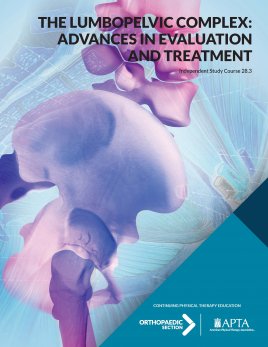
The Lumbopelvic Complex
| Online Only | |
|---|---|
| APTA Orthopedics Member | $65 |
| Non-APTA Orthopedics Member | $115 |
Note: CEUs are not offered for this course.
Course Description
This course provides a comprehensive resource for the clinician who seeks evaluation and treatment expertise for patients who suffer low back pain. Particular emphasis is placed on defining the facets governing spinal stability, assessing movement patterns, and differentiating among types of pain and how each is effected in patients with low back pathology. Specific monographs are dedicated to the geriatric and pediatric populations. A unique feature of the course is the inclusion of over 39 patient resource pamphlets that can be used for patient education.
Course Overview
Course Format: Online
Course Objectives
- Demonstrate an understanding of the value of assessing serious pathologies and co-morbidities in managing patients with low back pain.
- Demonstrate an appropriate interpretation of the patient’s history and physical examination findings into patterns that guide the treatment.
- Recognize acute and subacute low back pain patterns and the rehabilitation that is prescribed for each.
- Understand the theoretical basis for spinal stability and movement coordination.
- Formulate a structured evidence-based examination algorithm to identify relevant movement coordination impairments of the lumbopelvic complex.
- Apply the examination algorithm to develop optimal procedural interventions with regard to proper exercise dosing.
- Define different types of pain and identify common pain patterns.
- Describe the relevant clinical anatomy of the lumbopelvic region to allow for accurate clinical examination and identification of possible sources of symptoms.
- Understand the most common clinical presentations of low back pain with radiating pain conditions to provide a framework for the clinical examination.
- Understand the basis and progression of neuropathic pain and the development of chronic pain syndromes.
- Screen for possible sources of low back pain that require medical referral.
- Use and interpret appropriate psychosocial screening tools to assist in identifying personal factors that influence patient management and prognosis.
- Integrate research evidence to support the use of manual therapy, including high-velocity low-amplitude spinal mobilizations in the treatment of low back pain with radiating pain.
- Discuss current evidence for non-pharmacologic and pharmacologic interventions for older adults with low back pain.
- Identify one or more strategies for incorporating patient-centered care into the plan of care for an older adult with low back pain.
- Develop an understanding of evidence-based management of adolescents with low back pain and when imaging is indicated.
- Understand the concepts of exercise progression to prepare a treatment program for an adolescent athlete, beginning with simple, early stage exercises progressing to advanced, sport-specific movements
Topics and Authors
- Acute and Subacute Lumbopelvic Deficits: Lumbosacral Segmental/ Somatic Dysfunction
Muhammad Alrwaily, PT, MS, PhD, COMT; Michael Timko, PT, MS, FAAOMPT - Acute, Subacute, and Recurrent Low Back Pain with Movement Coordination Impairments
Won Sung, PT, DPT, PhD; Ejona Jeblonski, PT, DPT - Acute and Subacute Low Back with Radiating Pain
Robert Rowe, PT, DPT, DMT, MHS, FAAOMPT; Laura Langer PT, DPT, OCS FAAOMPT; Fernando Malaman, PT, DPT, OCS, FAAOMPT; Nata Salvatori, PT, DPT, OCS, SCS, FAAOMPT; Timothy Shreve, PT, OCS, FAAOMPT - Low Back in the Geriatric Population
Jacqueline Osborne, DPT, GCS, CEEAA; Raine Osborne, DPT, OCS, FAAOMPT; Lauren Nielsen, DPT, OCS, FAAOMPT; Robert H. Rowe, PT, DPT, DMT, MHS, FAAOMPT - Adolescent Spine
Anthony Carroll, PT, DPT, CSCS, OCS, FAAOMPT; Melissa Dreger, PT, DPT, OCS; Patrick O’Rourke, PT, DPT, OCS; Tara Jo Manal, PT, DPT, OCS, SCS, FAPTA - Patient Educational Resources for the Spine Patient
W. Gregory Seymour, PT, DPT, OCS; J. Megan Sions, DPT, PhD, OCS; Michael Palmer, PT, DPT, OCS; Tara Jo Manal, PT, DPT, OCS, SCS, FAPTA
Videos
Add To Cart
Which version of the course would you like to purchase?
Members Only
You need to be a member to buy this course.
Join today to enjoy exclusive deals and prices on all courses.
Join Now